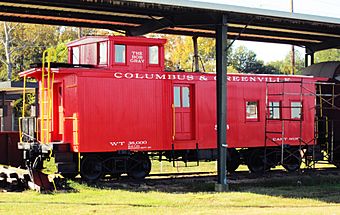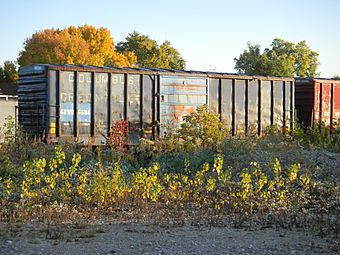Columbus and Greenville Railway facts for kids

A C&G caboose on display in Columbus, Mississippi
|
|
| Overview | |
|---|---|
| Headquarters | Columbus, Mississippi |
| Reporting mark | C&G |
| Locale | Mississippi |
| Dates of operation | 1923–1972 |
| Predecessor | Southern Railway in Mississippi |
| Successor | Illinois Central Gulf Railroad |
| Technical | |
| Track gauge | 4 ft 8 1⁄2 in (1,435 mm) standard gauge |
 |
|

A former Columbus and Greenville Railway boxcar in Cedar Rapids, Iowa
|
|
| Overview | |
|---|---|
| Headquarters | Columbus, Mississippi |
| Reporting mark | CAGY |
| Locale | Mississippi |
| Dates of operation | 1975–present |
| Predecessor | Illinois Central Gulf Railroad |
| Technical | |
| Track gauge | 4 ft 8 1⁄2 in (1,435 mm) standard gauge |
| Length | 162 miles (261 km) |
The Columbus and Greenville Railway is a name used for a train line in Mississippi. Interestingly, this name has been used twice for the same railway route! Let's learn about both versions of this important train line.
Contents
The First Columbus and Greenville Railway (1923-1972)
The first Columbus and Greenville Railway, known as the C&G, started in 1923. It was created when the Southern Railway sold its Mississippi line to local people.
Trains on this line carried many different goods. In 1952, the C&G stopped using steam locomotives. Their last steam engine was a large one built in 1904. The C&G operated on its own until 1972. Then, a bigger company called the Illinois Central Gulf Railroad bought it.
The Modern Columbus and Greenville Railway (1975-Present)
The second Columbus and Greenville Railway, called CAGY, began in 1975. It started operating on tracks that the Illinois Central Gulf Railroad no longer wanted. These tracks stretched across the state of Mississippi.

The railway connects the cities of Columbus and Greenville, Mississippi. In 2001, a big flood washed out part of the track. This happened between West Point and Greenwood. Because of this, the train line was split into two separate parts.
How the Railway Operates Today
The western part of the line runs between Greenville and Greenwood. It connects with another large train company, Canadian National, in Greenwood. The eastern part of the line operates from West Point towards Columbus.
The Columbus and Greenville Railway used to mainly transport wood and paper. Now, it carries many other things. These include bricks, plastic items, and food for animals like catfish and pigs. They also move steel, cotton, rice, and even fuel called biodiesel. The company runs six trains every day. Two trains run between Greenwood and Greenville. Two more run out of Columbus. The last two trains serve a steel mill between Columbus and Artesia.
Who Owns the Railway?
Most of the Columbus and Greenville Railway is owned by a company called CAGY Industries. This company also owns other train lines, like the Luxapalila Valley Railroad.
In 2008, a bigger company named Genesee & Wyoming Inc. bought CAGY Industries. This company still operates the train sections today. They run trains between Greenville and Greenwood, and between West Point and Columbus.
Preserving Railway History
Some old equipment from the Columbus and Greenville Railway has been saved. You can see these pieces on display in different towns:
- Locomotive #601 is in front of the Columbus & Greenville shops in Columbus, MS.
- Locomotive #606, named "City of Moorhead," is at the Illinois Railway Museum.
- Caboose #500 is on display in Winona, MS, near the train station.
- Caboose #503 is in Propst Park in Columbus, MS. It's displayed with some old passenger cars and another steam locomotive.
- Caboose #506 is in downtown Kosciusko, MS.
- Caboose #508 is in front of a doctor's office in Greenwood, MS.
The C&G Rail Trail Project
A group called the C&G Rail Trail Coalition started in 2008. Their goal was to turn the abandoned section of track between Greenwood and West Point into a walking and biking trail. This type of trail is called a rail trail.
Their plans were put on hold when Genesee & Wyoming Inc. bought the line. The new owners were not ready to give up the tracks. However, in 2022, the Genesee & Wyoming company talked to the Coalition again.
As of April 2023, the Coalition is working hard on the project. They are getting help from the Mississippi Hills National Heritage Area and towns along the route. They are trying to get money and make plans to buy the old line. Then, they can turn it into a fun trail for everyone to use. Some people who own land near the tracks are not happy about the trail being built.

